Thérèse of Lisieux
Thérèse of Lisieux OCD (French: Thérèse de Lisieux [te.ʁɛz də li.zjø]), born Marie Françoise-Thérèse Martin (2 January 1873 – 30 September 1897), also known as Saint Therese of the Child Jesus and the Holy Face (Thérèse de l'Enfant Jésus et de la Sainte Face), was a French Catholic Discalced Carmelite nun who is widely venerated in modern times. She is popularly known in English as the Little Flower of Jesus, or simply the Little Flower, and in French as la petite Thérèse (little Thérèse).[2][3]
Saint Therese of the Child Jesus and the Holy Face OCD | |
|---|---|
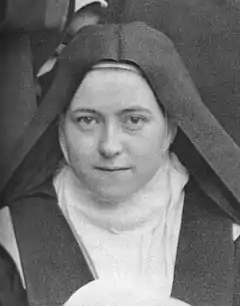 Saint Therese of the Child Jesus | |
| Doctor of the Church, Virgin | |
| Born | Marie Françoise-Thérèse Martin 2 January 1873 Alençon,[1] Orne, France |
| Died | 30 September 1897 (aged 24) Lisieux, Calvados, France |
| Venerated in | Catholic Church Anglican Communion |
| Beatified | 29 April 1923 by Pope Pius XI |
| Canonized | 17 May 1925 by Pope Pius XI |
| Major shrine |
|
| Feast |
|
| Attributes | Discalced Carmelite habit, crucifix, roses |
| Patronage | Missionaries; France; Russia; HIV/AIDS survivors; florists and gardeners; orphaned children; homeless peoples; tuberculosis; the Russicum; Alaska; Pasay; Antipolo; Santa Teresita, Batangas; Pueblo, Colorado; Fresno, California; Cheyenne, Wyoming; Kisumu; Witbank; Gardens of Vatican City; Archdiocese of Trivandrum |
| Part of a series on |
| Christian mysticism |
|---|
 |
Thérèse has been a highly influential model of sanctity for Catholics and for others because of the simplicity and practicality of her approach to the spiritual life. She is one of the most popular saints in the history of the church.[4][5] Pope Pius X called her "the greatest saint of modern times".[6][7]
Thérèse felt an early call to religious life and, after overcoming various obstacles, in 1888, at the early age of 15,[8] she became a nun and joined two of her older sisters in the cloistered Carmelite community of Lisieux, Normandy (yet another sister, Céline, also later joined the order). After nine years as a Carmelite religious, having fulfilled various offices such as sacristan and assistant to the novice mistress, in her last eighteen months in Carmel she fell into a night of faith, in which she is said to have felt Jesus was absent and been tormented by doubts that God existed. Thérèse died at the age of 24 from tuberculosis.
Her feast day in the General Roman Calendar was 3 October from 1927 until it was moved in 1969 to 1 October.[9] Thérèse is well known throughout the world, with the Basilica of Lisieux being the second most popular place of pilgrimage in France after Lourdes.
Life
Family background
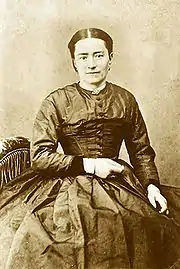
Therese was born on Rue Saint-Blaise, in Alençon, France on January 2, 1873, and was the daughter of Marie-Azélie Guérin (usually called Zélie), and Louis Martin who was a jeweler and watchmaker.[10] Both her parents were devout Catholics who would eventually become the first (and to date only) married couple canonized together by the Roman Catholic Church (by Pope Francis in 2015).
Louis had tried to become a canon regular, wanting to enter the Great St Bernard Hospice, but had been refused because he did not know Latin. Zélie, possessed of a strong, active temperament, wished to serve the sick, and had also considered entering consecrated life, but the prioress of the canonesses regular of the Hôtel-Dieu in Alençon had discouraged her outright.[11] Disappointed, Zélie learned lacemaking instead. She excelled in it and set up her own business on Rue Saint-Blaise at age 22.[12]
Louis and Zélie met in early 1858 and married on July 13 of that same year at the Basilica of Notre-Dame d'Alençon. At first they decided to live as brother and sister in a perpetual continence, but when a confessor discouraged them in this, they changed their lifestyle and had nine children. From 1867 to 1870, they lost 3 infants and five-year-old Hélène. All five of their surviving daughters became nuns. In addition to Therese, they were:
- Marie (February 22, 1860, a Carmelite in Lisieux, in religion Sister Marie of the Sacred Heart, d. January 19, 1940),
- Pauline (September 7, 1861, a Carmelite in Lisieux, in religion Mother Agnes of Jesus, d. July 28, 1951),
- Léonie (June 3, 1863, a Visitandine at Caen, in religion Sister Françoise-Thérèse, d. June 16, 1941), and
- Céline (April 28, 1869, a Carmelite in Lisieux, in religion Sister Geneviève of the Holy Face, d. February 25, 1959).
"A dreamer and brooder, an idealist and romantic, [the father] gave touching and naïve pet names [to his daughters]: Marie was his 'diamond', Pauline his 'noble pearl', Céline 'the bold one'. But Therese was his 'little queen', to whom all treasures belonged."[13]
Zélie was so successful in manufacturing lace that by 1870 Louis had sold his watchmaking shop to a nephew and handled the traveling and bookkeeping end of his wife's lacemaking business.
Birth and infancy
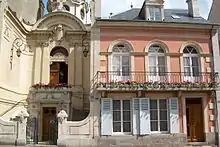
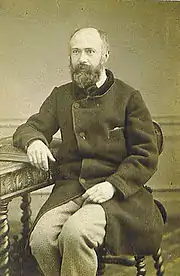
Soon after her birth in January 1873, the outlook for the survival of Therese Martin was uncertain. Because of her frail condition, she was entrusted to a wet nurse, Rose Taillé, who had already nursed two of the Martin children.[14] Rose had her own children and could not live with the Martins, so Therese was sent to live with her in the bocage forests of Semallé.

On 2 April 1874, when she was 15 months old, she returned to Alençon where her family surrounded her with affection. "I hear the baby calling me Mama! as she goes down the stairs. On every step, she calls out Mama! and if I don't respond every time, she remains there without going either forward or back." (Madame Martin to Pauline, 21 November 1875) She was educated in a very Catholic environment, including Mass attendance at 5:30 a.m., the strict observance of fasts, and prayer to the rhythm of the liturgical year. The Martins also practiced charity, visiting the sick and elderly and welcoming the occasional vagabond to their table. Even if she was not the model little girl, her sisters later portrayed, Therese was very responsive to this education. She played at being a nun. Described as generally a happy child, she also manifested other emotions, and often cried: "Céline is playing with the little one with some bricks […] I have to correct poor baby who gets into frightful tantrums when she can't have her own way. [15] She rolls in the floor in despair believing all is lost. Sometimes she is so overcome she almost chokes. She's a nervous child, but she is very good, very intelligent, and remembers everything."[14] At 22, Therese, then a Carmelite, admitted: "I was far from being a perfect little girl".[16]
From 1865 Zélie had complained of breast pain and in December 1876 a doctor told her of the seriousness of the tumour. Feeling death was imminent, Madame Martin had written to Pauline in spring 1877, "You and Marie will have no difficulties with her upbringing. Her disposition is so good. She is a chosen spirit." In June 1877 she left for Lourdes hoping to be cured, but the miracle did not happen: "The Mother of God has not healed me because my time is up, and because God wills me to repose elsewhere than on the earth." On 28 August 1877, Zélie died, aged 45. Her funeral was conducted in the Basilica of Notre-Dame d'Alençon. Therese was barely 41⁄2 years old. Her mother's death dealt her a severe blow and later she would consider that "the first part of her life stopped that day".
She wrote: "Every detail of my mother's illness is still with me, specially her last weeks on earth." She remembered the bedroom scene where her dying mother received the last sacraments while Therese knelt and her father cried. She wrote: "When Mummy died, my happy disposition changed. I had been so lively and open; now I became diffident and oversensitive, crying if anyone looked at me. I was only happy if no one took notice of me… It was only in the intimacy of my own family, where everyone was wonderfully kind, that I could be more myself."[17][18]
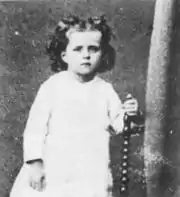
Three months after Zélie died, Louis Martin left Alençon, where he had spent his youth and marriage, and moved to Lisieux in the Calvados Department of Normandy, where Zélie's pharmacist brother, Isidore Guérin lived with his wife and their two daughters, Jeanne and Marie. In her last months Zélie had given up the lace business. After her death, Louis sold it. Louis leased a pretty, spacious country house, Les Buissonnets, situated in a large garden on the slope of a hill overlooking the town. Looking back, Therese would see the move to Les Buissonnets as the beginning of the "second period of my life, the most painful of the three: it extends from the age of four-and-a-half to fourteen, the time when I rediscovered my childhood character, and entered into the serious side of life".[19] In Lisieux, Pauline took on the role of Therese's "Mama". She took this role seriously, and Therese grew especially close to her, and to Céline, the sister closest to her in age.[14]
Early years

Therese was taught at home until she was eight and a half, and then entered the school kept by the Benedictine nuns of the Abbey of Notre Dame du Pre in Lisieux. Therese, taught well and carefully by Marie and Pauline, found herself at the top of the class, except for writing and arithmetic. However, because of her young age and high grades, she was bullied. The one who bullied her the most was a girl of fourteen who did poorly at school. Therese suffered very much as a result of her sensitivity, and she cried in silence. Furthermore, the boisterous games at recreation were not to her taste. She preferred to tell stories or look after the little ones in the infants class. "The five years I spent at school were the saddest of my life, and if my dear Céline had not been with me I could not have stayed there for a single month without falling ill." Céline informs us, "She now developed a fondness for hiding,[20] she did not want to be observed, for she sincerely considered herself inferior".[21] On her free days she became more and more attached to Marie Guérin, the younger of her two cousins in Lisieux. The two girls would play at being anchorites, as the great Teresa had once played with her brother. And every evening she plunged into the family circle. "Fortunately I could go home every evening and then I cheered up. I used to jump on Father's knee and tell him what marks I had, and when he kissed me all my troubles were forgotten… I needed this sort of encouragement so much." Yet the tension of the double life and the daily self-conquest placed a strain on Therese. Going to school became more and more difficult.
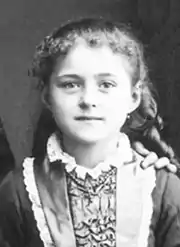
When she was nine years old, in October 1882, her sister Pauline, who had acted as a "second mother" to her, entered the Carmelite convent at Lisieux. Therese was devastated. She understood that Pauline was cloistered and that she would never come back. "I said in the depths of my heart: Pauline is lost to me!" The shock reawakened in her the trauma caused by her mother's death. She also wanted to join the Carmelites, but was told she was too young. Yet Therese so impressed Mother Marie Gonzague, the prioress at the time of Pauline's entry to the community that she wrote to comfort her, calling Therese "my future little daughter".
Illness
At this time, Therese was often sick. She began to suffer from nervous tremors. The tremors started one night after her uncle took her for a walk and began to talk about Zélie. Assuming that she was cold, the family covered Therese with blankets, but the tremors continued. She clenched her teeth and could not speak. The family called Dr. Notta, who could make no diagnosis.[22] In 1882, Dr. Gayral diagnosed that Therese "reacts to an emotional frustration with a neurotic attack".[23]
Alarmed, but cloistered, Pauline began to write letters to Therese and attempted various strategies to intervene. Eventually Therese recovered after she had turned to gaze at the statue of the Virgin Mary placed in Marie's room, where Therese had been moved.[24] She reported on 13 May 1883 that she had seen the Virgin smile at her.[25] She wrote: "Our Blessed Lady has come to me, she has smiled upon me. How happy I am."[26] However, when Therese told the Carmelite nuns about this vision at the request of her eldest sister Marie, she found herself assailed by their questions and she lost confidence. Self-doubt made her begin to question what had happened. "I thought I had lied – I was unable to look upon myself without a feeling of profound horror."[27] "For a long time after my cure, I thought that my sickness was deliberate and this was a real martyrdom for my soul".[28] Her concerns over this continued until November 1887.
In October 1886, her oldest sister, Marie, entered the same Carmelite monastery, adding to Therese's grief. The warm atmosphere at Les Buissonnets, so necessary to her, was disappearing. Now only she and Céline remained with their father. Her frequent tears made some friends think she had a weak character and the Guérins indeed shared this opinion.
Therese also suffered from scruples, a condition experienced by other saints such as Alphonsus Liguori, also a Doctor of the Church, and Ignatius Loyola, the founder of the Jesuits. She wrote: "One would have to pass through this martyrdom to understand it well, and for me to express what I experienced for a year and a half would be impossible".[29]
Complete conversion
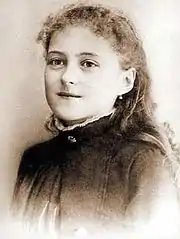
Christmas Eve of 1886 was a turning point in the life of Therese; she called it her "complete conversion." Years later she stated that on that night she overcame the pressures she had faced since the death of her mother and said that "God worked a little miracle to make me grow up in an instant […] On that blessed night… Jesus, who saw fit to make Himself a child out of love for me, saw fit to have me come forth from the swaddling clothes and imperfections of childhood".[30]
That night, Louis Martin and his daughters, Léonie, Céline and Thérèse, attended Midnight Mass at the cathedral in Lisieux – "but there was very little heart left in them. On 1 December, Léonie, covered in eczema and hiding her hair under a short mantilla, had returned to Les Buissonnets after just seven weeks of the Poor Clares regime in Alençon", and her sisters were helping her get over her sense of failure and humiliation. Back at Les Buissonnets as every year, Thérèse "as was the custom for French children, had left her shoes on the hearth, empty in anticipation of gifts, not from Father Christmas but from the Child Jesus, who was imagined to travel through the air bearing toys and cakes."[31] While she and Céline were going up the stairs she heard her father, "perhaps exhausted by the hour, or this reminder of the relentless emotional demands of his weepy youngest daughter", say with some irritation "Therese is far too old for this now. Fortunately this will be the last year!" Therese had begun to cry and Céline advised her not to go back downstairs immediately. Then, suddenly, Therese pulled herself together and wiped her tears. She ran down the stairs, knelt by the fireplace and unwrapped her surprises as jubilantly as ever. In her account, nine years later, of 1895: "In an instant Jesus, content with my good will, accomplished the work I had not been able to do in ten years." After nine sad years she had "recovered the strength of soul she had lost" when her mother died and, she said, "she was to retain it forever". She discovered the joy in self-forgetfulness and added, "I felt, in a word, charity enter my heart, the need to forget myself to make others happy – Since this blessed night I was not defeated in any battle, but instead I went from victory to victory and began, so to speak, 'to run a giant's course'."[lower-alpha 1]
According to Ida Görres, "Therese instantly understood what had happened to her when she won this banal little victory over her sensitivity, which she had borne for so long; …freedom is found in resolutely looking away from oneself... and the fact that a person can cast himself away from himself reveals again that being good, victory is pure grace, a sudden gift... It cannot be coerced, and yet it can be received only by the patiently prepared heart".[32] Biographer Kathryn Harrison: "After all, in the past she had tried to control herself, had tried with all her being and had failed. Grace, alchemy, masochism: through whatever lens we view her transport, Therese's night of illumination presented both its power and its danger. It would guide her steps between the mortal and the divine, between living and dying, destruction and apotheosis. It would take her exactly where she intended to go".[33]
Therese's character and the early experiences that shaped her have been the subject of analysis, particularly in recent years. Apart from the family doctor who observed her in the 19th century, all other conclusions are inevitably speculative. For instance, author Ida Görres, whose formal studies had focused on church history and hagiography, wrote a psychological analysis of the Therese's character. Some authors suggest that Therese had a strongly neurotic aspect to her personality for most of her life.[34][35][36][37] Harrison concluded that, "her temperament was not formed for compromise or moderation … a life spent not taming but directing her appetite and her will, a life perhaps shortened by the force of her desire and ambition."[31]
Rome and entry to Carmel
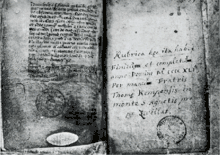
Before she was fourteen, when she started to experience a period of calm, Therese started to read The Imitation of Christ. She read the Imitation intently, as if the author traced each sentence for her: "The Kingdom of God is within you… Turn thee with thy whole heart unto the Lord; and forsake this wretched world: and thy soul shall find rest."[38] She kept the book with her constantly and wrote later that this book and parts of another book of a very different character, lectures by Abbé Arminjon on The End of This World, and the Mysteries of the World to Come, nourished her during this critical period.[39] Thereafter she began to read other books, mostly on history and science.[40]
In May 1887, Therese approached her 63-year-old father Louis, who was recovering from a small stroke, while he sat in the garden one Sunday afternoon and told him that she wanted to celebrate the anniversary of "her conversion" by entering Carmel before Christmas. Louis and Thérèse both broke down and cried, but Louis got up, gently picked a little white flower, root intact, and gave it to her, explaining the care with which God brought it into being and preserved it until that day. Thérèse later wrote: "while I listened I believed I was hearing my own story". To Therese, the flower seemed a symbol of herself, "destined to live in another soil". Therese renewed her attempts to join the Carmel, but the priest-superior of the monastery would not allow it on account of her youth.
.jpg.webp)
During the summer, French newspapers were filled with the story of Henri Pranzini, convicted of the brutal murder of two women and a child. To the outraged public Pranzini represented all that threatened the decent way of life in France. In July and August 1887 Therese prayed hard for the conversion of Pranzini, so his soul could be saved, yet Pranzini showed no remorse. At the end of August, the newspapers reported that just as Pranzini's neck was placed on the guillotine, he had grabbed a crucifix and kissed it three times. Therese was ecstatic and believed that her prayers had saved him. She continued to pray for Pranzini after his death.[41]
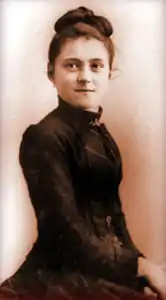

In November 1887, Louis took Céline and Therese on a diocesan pilgrimage to Rome for the priestly jubilee of Pope Leo XIII. On 20 November 1887, during a general audience with Leo XIII, Therese, in her turn, approached the Pope, knelt, and asked him to allow her to enter Carmel at 15. The Pope said: "Well, my child, do what the superiors decide… You will enter if it is God's Will" and he blessed Therese. She refused to leave his feet, and the Noble Guard had to carry her out of the room.[43]
The trip continued: they visited Pompeii, Naples, Assisi before going back via Pisa and Genoa. The pilgrimage of nearly a month was timely. During it she "learnt more than in many years of study". For the first and last time in her life, she left her native Normandy. Notably she "who only knew priests in the exercise of their ministry was in their company, heard their conversations, not always edifying – and saw their shortcomings for herself".[44]
She had understood that she had to pray and give her life for sinners like Pranzini. But Carmel prayed especially for priests and this had surprised her since their souls seemed to her to be "as pure as crystal". A month spent with many priests taught her that they are "weak and feeble men". She wrote later: "I met many saintly priests that month, but I also found that in spite of being above angels by their supreme dignity, they were none the less men and still subject to human weakness. If the holy priests, 'the salt of the earth', as Jesus calls them in the Gospel, have to be prayed for, what about the lukewarm? Again, as Jesus says, 'If the salt shall lose its savour, wherewith shall it be salted?' I understood my vocation in Italy." For the first time too she had associated with young men. "In her brotherless existence, masculinity had been represented only by her father, her Uncle Guérin and various priests. Now she had her first and only experiences. Céline declared at the beatification proceedings that one of the young men in the pilgrimage group "developed a tender affection for her". Thérèse confessed to her sister, "It is high time for Jesus to remove me from the poisonous breath of the world […] I feel that my heart is easily caught by tenderness, and where others fall, I would fall too. We are no stronger than the others".[45] Soon after that, the Bishop of Bayeux authorized the prioress to receive Thérèse. On 9 April 1888 she became a Carmelite postulant.
Lisieux Carmel
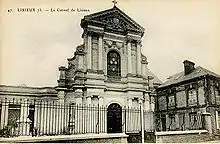
The convent Thérèse entered was an old-established house with a long tradition. In 1838 two nuns from the Poitiers Carmel had been sent out to found the house of Lisieux. One of them, Mother Geneviève of St Teresa, was still living. When Thérèse entered the second wing, containing the cells and sickrooms in which she was to live and die, which had been standing only ten years, "What she found was a community of very aged nuns, some odd and cranky, some sick and troubled, some lukewarm and complacent. Almost all of the sisters came from the petty bourgeois and artisan class. The Prioress and Novice Mistress were of old Normandy nobility. Probably the Martin sisters alone represented the new class of the rising bourgeoisie".[46]
The Carmelite order had been reformed in the sixteenth century by Teresa of Ávila, essentially devoted to personal and collective prayer. The nuns of Lisieux followed a strict regimen that allowed for only one meal a day for seven months of the year, and little free time. Only one room of the building was heated. The times of silence and of solitude were many but the foundress had also planned for time for work and relaxation in common – the austerity of the life should not hinder sisterly and joyful relations. Founded in 1838, the Carmel of Lisieux in 1888 had 26 religious, from very different classes and backgrounds. For the majority of the life of Therese, the prioress would be Mother Marie de Gonzague, born Marie-Adéle-Rosalie Davy de Virville. When Therese entered the convent Mother Marie was 54, a woman of changeable humour, jealous of her authority, used sometimes in a capricious manner; this had for effect, a certain laxity in the observance of established rules. "In the sixties and seventies of the [nineteenth] century an aristocrat in the flesh counted for far more in a petty bourgeois convent than we can realize nowadays […] the superiors appointed Marie de Gonzague to the highest offices as soon as her noviciate was finished […] in 1874 began the long series of terms as Prioress".[47]
Postulancy
Therese's time as a postulant began with her welcome into the Carmel, Monday, 9 April 1888.[48] She felt peace after she received communion that day and later wrote, "At last my desires were realized, and I cannot describe the deep sweet peace which filled my soul. This peace has remained with me during the eight and a half years of my life here, and has never left me even amid the greatest trials".[49]
From her childhood, Therese had dreamed of the desert to which God would some day lead her. Now she had entered that desert. Though she was now reunited with Marie and Pauline, from the first day she began her struggle to win and keep her distance from her sisters. Right at the start Marie de Gonzague, the prioress, had turned the postulant Therese over to her eldest sister Marie, who was to teach her to follow the Divine Office. Later she appointed Therese assistant to Pauline in the refectory. When her cousin Marie Guerin also entered, she employed the two together in the sacristy.
Therese adhered strictly to the rule which forbade all superfluous talk during work. She saw her sisters together only in the hours of common recreation after meals. At such times she would sit down beside whomever she happened to be near, or beside a nun whom she had observed to be downcast, disregarding the tacit and sometimes expressed sensitivity and even jealousy of her biological sisters. "We must apologize to the others for our being four under one roof", she was in the habit of remarking. "When I am dead, you must be very careful not to lead a family life with one another […] I did not come to Carmel to be with my sisters; on the contrary, I saw clearly that their presence would cost me dear, for I was determined not to give way to nature."
Although the novice mistress, Sister Marie of the Angels, found Therese slow, the young postulant adapted well to her new environment. She wrote, "Illusions, the Good Lord gave me the grace to have none on entering Carmel. I found religious life as I had figured, no sacrifice astonished me."
She chose a spiritual director, a Jesuit, Father Pichon. At their first meeting, 28 May 1888, she made a general confession going back over all her past sins. She came away from it profoundly relieved. The priest who had himself suffered from scruples, understood her and reassured her.[50] A few months later, he left for Canada, and Therese would only be able to ask his advice by letter and his replies were rare. (On 4 July 1897, she confided to Pauline, "Father Pichon treated me too much like a child; nonetheless he did me a lot of good too by saying that I never committed a mortal sin.") During her time as a postulant, Therese had to endure some bullying from other sisters because of her lack of aptitude for handicrafts and manual work. Sister St Vincent de Paul, the finest embroiderer in the community made her feel awkward and even called her 'the big nanny goat'. Therese was in fact the tallest in the family at 1.62 m (5 ft 4 in). Pauline, the shortest, was no more than 1.54 m (5 ft 1⁄2 in) tall.
Like all religious she discovered the ups and downs related to differences in temperament, character, problems of sensitivities or infirmities. After nine years she wrote plainly, "the lack of judgment, education, the touchiness of some characters, all these things do not make life very pleasant. I know very well that these moral weaknesses are chronic, that there is no hope of cure". But the greatest suffering came from outside Carmel. On 23 June 1888, Louis Martin disappeared from his home and was found days later, in the post office in Le Havre. The incident marked the onset of her father's decline. He died on July 29, 1894.
Novitiate

The end of Therese's time as a postulant arrived on the January 10, 1889, with her taking of the habit. From that time she wore the "rough homespun and brown scapular, white wimple and veil, leather belt with rosary, woollen 'stockings', rope sandals".[51] Her father's health having temporarily stabilized he was able to attend, though twelve days after her ceremony her father suffered a stroke and was taken to a private sanatorium, the Bon Sauveur at Caen, where he remained for three years before returning to Lisieux in 1892. In this period Therese deepened the sense of her vocation; to lead a hidden life, to pray and offer her suffering for priests, to forget herself, to increase discreet acts of charity. She wrote, "I applied myself especially to practice little virtues, not having the facility to perform great ones […] In her letters from this period of her novitiate, Therese returned over and over to the theme of littleness, referring to herself as a grain of sand, an image she borrowed from Pauline… 'Always littler, lighter, in order to be lifted more easily by the breeze of love'.[52] The remainder of her life would be defined by retreat and subtraction".[53]
She absorbed the work of John of the Cross, spiritual reading uncommon at the time, especially for such a young nun. "Oh! what insights I have gained from the works of our holy father, St. John of the Cross! When I was seventeen and eighteen, I had no other spiritual nourishment…" She felt a kinship with this classic writer of the Carmelite Order (though nothing seems to have drawn her to the writing of Teresa of Avila), and with enthusiasm she read his works, The Ascent of Mount Carmel, the Way of Purification, the Spiritual Canticle, the Living Flame of Love. Passages from these writings are woven into everything she herself said and wrote.[54] The fear of God, which she found in certain sisters, paralyzed her. "My nature is such that fear makes me recoil, with LOVE not only do I go forward, I fly".[55]
With the new name a Carmelite receives when she enters the Order, there is always an epithet – for example, Teresa of Jesus, Elizabeth of the Trinity, Anne of the Angels. The epithet singles out the Mystery which she is supposed to contemplate with special devotion. "Therese's names in religion – she had two – must be taken together to define their religious significance".[56] The first name was promised to her at nine, by Mother Marie de Gonzague, of the Child Jesus, and was given to her on her entry to the convent. In itself, veneration of the childhood of Jesus was a Carmelite heritage of the seventeenth century – it concentrated upon the staggering humiliation of divine majesty in assuming the shape of extreme weakness and helplessness. The French Oratory of Jesus and Pierre de Bérulle renewed this old devotional practice. Yet when she received the veil, Therese herself asked Mother Marie de Gonzague to confer upon her the second name of the Holy Face.
Part of a series on |
| Catholic devotions to the Holy Face of Jesus |
|---|
 |
| Prayers and sacramentals |
|
| People |
|
| Organisations |
|
|
|
During the course of her novitiate, contemplation of the Holy Face was said to have nourished her inner life. This is an image representing the disfigured face of Jesus during the Passion. She meditated on certain passages from the prophet Isaiah (Chapter 53). Six weeks before her death she remarked to Pauline, "The words in Isaiah: 'no stateliness here, no majesty, no beauty, […] one despised, left out of all human reckoning; How should we take any account of him, a man so despised (Is 53:2–3)[57] – these words were the basis of my whole worship of the Holy Face. I, too, wanted to be without comeliness and beauty, unknown to all creatures."[58] On the eve of her profession she wrote to Sister Marie, "Tomorrow I shall be the bride of Jesus 'whose face was hidden and whom no man knew' – what a union and what a future!".[59] The meditation also helped her understand the humiliating situation of her father.
Usually the novitiate preceding profession lasted a year. Sister Therese hoped to make her final commitment on or after 11 January 1890 but, considered still too young for a final commitment, her profession was postponed. She would spend eight months longer than the standard year as an unprofessed novice. As 1889 ended, her old home in the world, Les Buissonnets, was dismantled, the furniture divided among the Guérins and the Carmel. It was not until 8 September 1890, aged 17 and a half, that she made her religious profession. The retreat in anticipation of her "irrevocable promises" was characterized by "absolute aridity" and on the eve of her profession she gave way to panic. She worried that "What she wanted was beyond her. Her vocation was a sham".[60]
Reassured by the novice mistress and mother Marie de Gonzague, the next day her religious profession went ahead, "an outpouring of peace flooded my soul, "that peace which surpasseth all understanding" (Phil. 4:7)".[61] Against her heart she wore her letter of profession written during her retreat. "May creatures be nothing for me, and may I be nothing for them, but may You, Jesus, be everything! Let nobody be occupied with me, let me be looked upon as one to be trampled underfoot […] may Your will be done in me perfectly… Jesus, allow me to save very many souls; let no soul be lost today; let all the souls in purgatory be saved…" On September 24, the public ceremony followed filled with 'sadness and bitterness'. "Therese found herself young enough, alone enough, to weep over the absence of Bishop Hugonin, Père Pichon, in Canada; and her own father, still confined in the asylum".[62] But Mother Marie de Gonzague wrote to the prioress of Tours, "The angelic child is seventeen and a half, and she has the judgment of one of thirty, the religious perfection of an old perfected novice, and possession of herself; she is a perfect religious."[33]
Life as a Carmelite
The years which followed were a maturation. Therese prayed without great sensitive emotions, she increased the small acts of charity and care for others, doing small services. She accepted criticism in silence, even unjust criticisms, and smiled at the sisters who were unpleasant to her. She always prayed for priests, and in particular for Father Hyacinthe Loyson, a famous preacher who had been a Sulpician and a Dominican novice before becoming a Carmelite and provincial of his order, but who had left the Catholic Church in 1869. Three years later he married a young Protestant widow, with whom he had a son. After his excommunication, he continued to travel around France giving lectures. While clerical papers called Loyson a "renegade monk" and Leon Bloy lampooned him, Therese prayed for her "brother". She offered her last communion, 19 August 1897, for Father Loyson.
The chaplain to the Carmel, Father Youf, insisted a lot on the fear of Hell. The preachers during spiritual retreats at that time emphasised sin, the sufferings of purgatory, and those of hell. This did not help Therese who in 1891 experienced, "great inner trials of all kinds, even wondering sometimes whether heaven existed." One phrase heard during a sermon made her weep: "No one knows if they are worthy of love or of hate." However the retreat of October 1891 was preached by Father Alexis Prou, a Franciscan from Saint-Nazaire. "He specialized in large crowds (he preached in factories) and did not seem the right person to help Carmelites. Just one of them found comfort in his words, Sister Thèrèse of the Child Jesus […] [his] preaching on abandonment and mercy expanded her heart".[63]
This confirmed her own intuitions. She wrote, "My soul was like a book which the priest read better than I did. He launched me full sail on the waves of confidence and love which held such an attraction for me, but upon which I had not dared to venture. He told me that my faults did not offend God." Her spiritual life drew more and more on the Gospels that she carried with her at all times. The piety of her time was fed more on commentaries, but Therese had asked Céline to get the Gospels and the Epistles of St Paul bound into a single small volume which she could carry on her heart. She said, "But it is especially the Gospels which sustain me during my hours of prayer, for in them I find what is necessary for my poor little soul. I am constantly discovering in them new lights, hidden and mysterious meanings."[64][65]
Over time Therese realised that she felt no attraction to the exalted heights of "great souls". She looked directly for the word of Jesus, which shed light on her prayers and on her daily life. Therese's retreat in October 1892 pointed to a "downward" path for her. If asked where she lived, she would pause and quote, "The foxes have their lairs, the birds of heaven their nests, but I have no place to rest my head." (Matthew 8:20). She wrote to Céline (letter 19 October 1892), "Jesus raised us above all the fragile things of this world whose image passes away. Like Zacchaeus, we climbed a tree to see Jesus and now let us listen to what he is saying to us. Make haste to descend, I must lodge today at your house. Well, Jesus tells us to descend?" "A question here of the interior," she qualified in her letter, lest Céline think she meant renouncing food or shelter. "Therese knew her virtues, even her love, to be flawed, flawed by self, a mirror too clouded to reflect the divine." She continued to seek to discover the means, "more efficiently to strip herself of self".[66] "No doubt, [our hearts] are already empty of creatures, but, alas, I feel mine is not entirely empty of myself, and it is for this reason that Jesus tells me to descend."[67]
Election of Mother Agnes
On 20 February 1893, Pauline was elected prioress of Carmel and became "Mother Agnes". She appointed the former prioress as novice mistress and made Therese her assistant. The work of guiding the novices would fall primarily to Therese. She repeated how important respect for the Rule was: "When any break the rule, this is not a reason to justify ourselves. Each must act as if the perfection of the Order depended on her personal conduct." She also affirmed the essential role of obedience in religious life. She said, "When you stop watching the infallible compass [of obedience], as quickly the mind wanders in arid lands where the water of grace is soon lacking."
Over the next few years she revealed a talent for clarifying doctrine to those who had not received as much education as she. A kaleidoscope, whose three mirrors transform scraps of coloured paper into beautiful designs, provided an inspired illustration for the Holy Trinity. "As long as our actions, even the smallest, do not fall away from the focus of Divine Love, the Holy Trinity, symbolized by the three mirrors, allows them to reflect wonderful beauty. Jesus, who regards us through the little lens, that is to say, through Himself, always sees beauty in everything we do. But if we left the focus of inexpressible love, what would He see? Bits of straw […] dirty, worthless actions".[68] "Another cherished image was that of the newly invented elevator, a vehicle Therese used many times over to describe God's grace, a force that lifts us to heights we can't reach on our own".[69][70] Martha of Jesus, a novice who spent her childhood in a series of orphanages and who was described by all as emotionally unbalanced, with a violent temper, gave witness during the beatification process of the 'unusual dedication and presence of her young teacher. "Therese deliberately 'sought out the company of those nuns whose temperaments she found hardest to bear.' What merit was there in acting charitably toward people whom one loved naturally? Therese went out of her way to spend time with, and therefore to love, the people she found repellent. It was an effective means of achieving interior poverty, a way to remove a place to rest her head".[69]
In September 1893, Therese, having been a temporarily professed for the standard three years, asked not to be promoted but to continue a novice indefinitely. As a novice she would always have to ask permission of the other, full sisters. She would never be elected to any position of importance. Remaining closely associated with the other novices, she could continue to care for her spiritual charges. In 1841 Jules Michelet devoted the major part of the fifth volume of his History of France to a favourable presentation of the epic of Joan of Arc. Félix Dupanloup worked relentlessly for the glorification of Joan who, on 8 May 1429 had liberated Orléans, the city of which he became bishop in 1849. Therese wrote two plays in honour of her childhood heroine, the first about Joan's response to the heavenly voices calling her to battle, the second about her resulting martyrdom.
1894 brought a national celebration of Joan of Arc. On 27 January, Leo XIII authorized the introduction of her cause of beatification, declaring Joan, the shepherdess from Lorraine "venerable". Thérèse used Henri Wallon's history of Joan of Arc – a book her uncle Isidore had given to the Carmel – to help her write two plays, "pious recreations", "small theatrical pieces performed by a few nuns for the rest of the community, on the occasion of certain feast days". The first of these, The Mission of Joan of Arc, was performed at the Carmel on 21 January 1894, and the second, Joan of Arc Accomplishes her Mission, exactly one year later, on 21 January 1895. In the estimation of one of her biographers, Ida Görres, they "are scarcely veiled self-portraits".[71] On 29 July 1894, Louis Martin died.
The "little way"
Therese entered the Carmel of Lisieux with the determination to become a saint. However, by the end of 1894, six years as a Carmelite made her realize how small and insignificant she felt. She saw the limitations of all her efforts. She remained small and very far off from the unfailing love that she would wish to practice. She is said to have understood then that it was from insignificance that she had to learn to ask God's help. Along with her camera, Céline had brought notebooks with her, passages from the Old Testament, which Therese did not have in Carmel. (The Louvain Bible, the translation authorized for French Catholics, did not include the Old Testament.) In the notebooks Therese found a passage from Proverbs that struck her with particular force: "Whosoever is a little one, let him come to me" (Proverbs 9:4).[72]
She was struck by another passage from the Book of Isaiah: "you shall be carried at the breasts, and upon the knees they shall caress you. As one whom the mother caresseth, so will I comfort you." (Isaiah 66:12–13)[73] She concluded that Jesus would carry her to the summit of sanctity. The smallness of Therese, her limits, became in this way grounds for joy, rather than discouragement. Not until Manuscript C of her autobiography did she give this discovery the name of little way, "petite voie"[74]
I will seek out a means of getting to Heaven by a little way – very short and very straight little way that is wholly new. We live in an age of inventions; nowadays the rich need not trouble to climb the stairs, they have lifts instead. Well, I mean to try and find a lift by which I may be raised unto God, for I am too tiny to climb the steep stairway of perfection. […] Thine Arms, then, O Jesus, are the lift which must raise me up even unto Heaven. To get there I need not grow. On the contrary, I must remain little, I must become still less[75]
In her quest for sanctity and in order to attain holiness and to express her love of God, she believed that it was not necessary to accomplish heroic acts or great deeds.[76] She wrote, "Love proves itself by deeds, so how am I to show my love? Great deeds are forbidden me. The only way I can prove my love is by scattering flowers and these flowers are every little sacrifice, every glance and word, and the doing of the least actions for love."
The little way of Therese is the foundation of her spirituality.[77] Within the Catholic Church Thérèse's way was known for some time as "the little way of spiritual childhood,"[8][76][78][79][80] but Therese actually wrote "little way" only three times,[74] and she never wrote the phrase "spiritual childhood." It was her sister Pauline who, after Therese's death, adopted the phrase "the little way of spiritual childhood" to interpret Therese's path.[81] Years after Therese's death, a Carmelite of Lisieux asked Pauline about this phrase and Pauline answered spontaneously "But you know well that Therese never used it! It is mine." In May 1897, Therese wrote to Father Adolphe Roulland, "My way is all confidence and love." To Maurice Bellière she wrote, "and I, with my way, will do more than you, so I hope that one day Jesus will make you walk by the same way as me."
Sometimes, when I read spiritual treatises in which perfection is shown with a thousand obstacles, surrounded by a crowd of illusions, my poor little mind quickly tires. I close the learned book which is breaking my head and drying up my heart, and I take up Holy Scripture. Then all seems luminous to me; a single word uncovers for my soul infinite horizons; perfection seems simple; I see that it is enough to recognize one's nothingness and to abandon oneself, like a child, into God's arms. Leaving to great souls, to great minds, the beautiful books I cannot understand, I rejoice to be little because only children, and those who are like them, will be admitted to the heavenly banquet.
Merciful love
At the end of the second play that Therese had written on Joan of Arc, the costume she wore almost caught fire. The alcohol stoves used to represent the stake at Rouen set fire to the screen behind which Therese stood. Therese did not flinch but the incident marked her. The theme of fire would assume an increasing importance in her writings.[82] On 9 June 1895, during a Mass celebrating the feast of the Holy Trinity, Therese had a sudden inspiration that she must offer herself as a sacrificial victim to merciful love. At this time some nuns offered themselves as a victim to God's justice. In her cell she drew up an 'Act of Oblation' for herself and for Céline, and on 11 June, the two of them knelt before the miraculous Virgin and Therese read the document she had written and signed. "In the evening of this life, I shall appear before You with empty hands, for I do not ask You Lord to count my works."
According to biographer, Ida Görres, the document echoed the happiness she had felt when Father Alexis Prou, the Franciscan preacher, had assured her that her faults did not cause God sorrow. In the Oblation she wrote, "If through weakness I should chance to fall, may a glance from Your Eyes straightway cleanse my soul, and consume all my imperfections – as fire transforms all things into itself".[83]
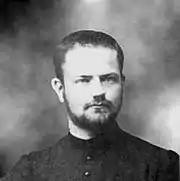
In August 1895 the four Martin sisters were joined in the convent by their cousin, Marie Guerin, who became Sister Marie of the Eucharist. Léonie, after several attempts, became Sister Françoise-Thérèse, a nun in the Order of the Visitation of Holy Mary in Caen, where she died in 1941.[64]
At age 14, Therese understood her vocation was to pray for priests, to be "an apostle to apostles". In September 1890, at her canonical examination before she professed her religious vows, she was asked why she had come to Carmel. She answered "I came to save souls, and especially to pray for priests". Throughout her life she prayed fervently for priests, and she corresponded with and prayed for a young priest, Adolphe Roulland, and a young seminarian, Maurice Bellière. She wrote to her sister "Our mission as Carmelites is to form evangelical workers who will save thousands of souls whose mothers we shall be."[48]
In October 1895 a young seminarian and subdeacon of the White Fathers, Abbé Bellière, asked the Carmel of Lisieux for a nun who would support – by prayer and sacrifice – his missionary work, and the souls that were in the future to be entrusted to him.[84] Mother Agnes designated Therese. She never met Father Bellière but ten letters passed between them.
A year later Father Adolphe Roulland (1870–1934) of the Society of Foreign Missions requested the same service of the Lisieux Carmel. Once more Therese was assigned the duties of spiritual sister. "It is quite clear that Therese, in spite of all her reverence for the priestly office, in both cases felt herself to be the teacher and the giver. It is she who consoles and warns, encourages and praises, answers questions, offers corroboration, and instructs the priests in the meaning of her little way".[85]
Final years
Therese's final years were marked by a steady decline that she bore resolutely and without complaint. Tuberculosis was the key element of Therese's final suffering, but she saw that as part of her spiritual journey. After observing a rigorous Lenten fast in 1896, she went to bed on the eve of Good Friday and felt a joyous sensation. She wrote: "Oh! how sweet this memory really is! […] I had scarcely laid my head upon the pillow when I felt something like a bubbling stream mounting to my lips. I didn't know what it was." The next morning her handkerchief was soaked in blood and she understood her fate. Coughing up of blood meant tuberculosis, and tuberculosis meant death. She wrote, "I thought immediately of the joyful thing that I had to learn, so I went over to the window. I was able to see that I was not mistaken. Ah! my soul was filled with a great consolation; I was interiorly persuaded that Jesus, on the anniversary of His own death, wanted to have me hear His first call!"[86]
Therese corresponded with a Carmelite mission in what was then French Indochina and was invited to join them, but, because of her sickness, could not travel. Tuberculosis slowly devoured her flesh. When she was near death, "Her physical suffering kept increasing so that even the doctor himself was driven to exclaim, "Ah! If you only knew what this young nun was suffering!"[87] During the last hours of Therese's life, she said, "I would never have believed it was possible to suffer so much, never, never!"[88] In July 1897, she made a final move to the monastery infirmary. On August 19, 1897, she received her last communion. She died on 30 September 1897, aged 24. On her deathbed, she is reported to have said, "I have reached the point of not being able to suffer any more, because all suffering is sweet to me." Her last words were, "My God, I love you!"[89]
Therese was buried on 4 October 1897, in the Carmelite plot, in the municipal cemetery at Lisieux, where her parents had been buried. Her body was exhumed in September 1910 and the remains placed in a lead coffin and transferred to another tomb.[90] In March 1923, however, before she was beatified, her body was returned to the Carmel of Lisieux, where it remains. The figure of Therese in the glass coffin is not her actual body but a gisant statue based on drawings and photos by Céline after Therese's death. It contains her ribcage and other remnants of her body.
Spirituality
| Part of a series on |
| Eucharistic adoration of the Catholic Church |
|---|
 |
| Papal documents |
|
| Organisations and events |
|
| Notable individuals |
|
| Eucharistic meditators |
|
|
|
To the right and to the left, I throw to my little birds the good grain that God places in my hands. And then I let things take their course! I busy myself with it no more. Sometimes, it's just as though I had thrown nothing; at other times, it does some good. But God tells me: 'Give, give always, without being concerned with the results'.[91]
Together with Francis of Assisi, Therese of Lisieux is one of the most popular Roman Catholic saints since apostolic times. She is approachable, due in part to her historical proximity. Barbara Stewart, writing for The New York Times, once called Therese "the Emily Dickinson of Roman Catholic sainthood".[92]
As a Doctor of the Church, she is the subject of much theological comment and study, and, as a young woman whose message has touched the lives of millions, she remains the focus of much popular devotion.[93] She was a highly influential model of sanctity for Catholics in the first half of the twentieth century because of the simplicity and practicality of her approach to the spiritual life.[94]
Therese was devoted to Eucharistic adoration and on 26 February 1895, shortly before she died wrote from memory and without a rough draft her poetic masterpiece "To Live by Love" which she had composed during Eucharistic adoration. During her life, the poem was sent to various religious communities and was included in a notebook of her poems.[95][96]
Therese lived a hidden life and "wanted to be unknown", yet became popular after her death through her spiritual autobiography. She also left letters, poems, religious plays, prayers, and her last conversations were recorded by her sisters. Paintings and photographs – mostly the work of her sister Céline – further led to her becoming known.
Therese said on her death-bed, "I only love simplicity. I have a horror of pretence", and she spoke out against some of the claims made concerning the lives of saints written in her day, "We should not say improbable things, or things we do not know. We must see their real, and not their imagined lives".[97] The depth of her spirituality, of which she said, "my way is all confidence and love", has inspired many believers up to the current day. In the face of her littleness she trusted to God her sanctity. She wanted to go to heaven by an entirely new little way. "I wanted to find an elevator that would raise me to Jesus". The elevator, she wrote, would be the arms of Jesus lifting her in all her littleness.[98]
Holy Face of Jesus devotion

The devotion to the Holy Face of Jesus was promoted by another Carmelite nun, Sister Marie of St Peter in Tours, France in 1844. Then by Leo Dupont, also known as the Apostle of the Holy Face who formed the Archconfraternity of the Holy Face in Tours in 1851.[99][100] Therese joined this confraternity on April 26, 1885.[101] Her parents, Louis and Zélie Martin, had also prayed at the Oratory of the Holy Face, originally established by Dupont in Tours.[102] This devotion to the Holy Face of Jesus was based on images of the Veil of Veronica, as promoted by Dupont, rather than the Shroud of Turin, which image first appeared on a photographic negative in 1898.
On 10 January 1889, she was given the habit and received the name Therese of the Child Jesus. On 8 September 1890, Therese took her vows. The ceremony of "taking the veil" followed on the 24th, when she added to her name in religion of the Holy Face, a title which was to become increasingly important in the development and character of her inner life.[103] In his "A l'ecole de Therese de Lisieux: maitresse de la vie spirituelle", Bishop Guy Gaucher emphasizes that Therese saw the devotions to the Child Jesus and to the Holy Face as so completely linked that she signed herself "Thérèse de l'Enfant Jesus de la Sainte Face" – Therese of the Child Jesus of the Holy Face. In her poem My Heaven down here, composed in 1895, Therese expressed the notion that by the divine union of love, the soul takes on the semblance of Christ. By contemplating the sufferings associated with the Holy Face of Jesus, she felt she could become closer to Christ.[104] She wrote the words "Make me resemble you, Jesus!" on a small card and attached a stamp with an image of the Holy Face. She pinned the prayer in a small container over her heart.
Therese wrote many prayers to express her devotion to the Holy Face. In August 1895, in her "Canticle to the Holy Face," she wrote: "Jesus, Your ineffable image is the star which guides my steps. Ah, You know, Your sweet Face is for me Heaven on earth. My love discovers the charms of Your Face adorned with tears. I smile through my own tears when I contemplate Your sorrows."
Therese emphasised God's mercy in both the birth and the passion narratives in the Gospel. She wrote, "He sees it disfigured, covered with blood! … unrecognizable! … And yet the divine Child does not tremble; this is what He chooses to show His love".[105]
She composed the Holy Face Prayer for Sinners: "Eternal Father, since Thou hast given me for my inheritance the adorable Face of Thy Divine Son, I offer that face to Thee and I beg Thee, in exchange for this coin of infinite value, to forget the ingratitude of souls dedicated to Thee and to pardon all poor sinners."[106] Over the decades, her poems and prayers helped to spread the devotion to the Holy Face of Jesus.[107]


Therese is best known today for her spiritual memoir, L'histoire d'une âme (The Story of a Soul). It is a compilation of three separate manuscripts. The first, in 1895 is a memoir of her childhood, written under obedience to the Prioress, Mother Agnes of Jesus, her older sister Pauline. Mother Agnes gave the order after being prompted by their eldest sister, Sister Marie of the Sacred Heart.[108]
The second is a three-page letter, written in September 1896, at the request of her eldest sister Marie, who, aware of the seriousness of Therese's illness, asked her to set down her "little doctrine".[64] In June 1897, Mother Agnes asked Mother Marie de Gonzague, who had succeeded her as prioress, to allow Therese to write another memoir with more details of her religious life (ostensibly as a help in the later composition of an anticipated obituary).[109]
While on her deathbed Therese made a number of references to the book's future appeal and benefit to souls. She authorized Pauline to make any changes deemed necessary. It was heavily edited by Pauline (Mother Agnes), who made more than seven thousand revisions to Therese's manuscript and presented it as a biography of her sister. Aside from considerations of style, Mother Marie de Gonzague had ordered Pauline to alter the first two sections of the manuscript to make them appear as if they were addressed to Mother Marie as well.[64] The book was sent out as the customary "circular" advising other Carmels of a nun's death and requesting their prayers. However, it received a much wider circulation, as copies were lent out and passed around.
Since 1973, two centenary editions of Therese's original, unedited manuscripts, including The Story of a Soul, her letters, poems,[110] prayers and the plays she wrote for the monastery recreations have been published in French. ICS Publications has issued a complete critical edition of her writings: Story of a Soul, Last Conversations, and the two volumes of her letters were translated by John Clarke, O.C.D.; The Poetry of Saint Thérèse by Donald Kinney, O.C.D.; The Prayers of St. Thérèse by Alethea Kane, O.C.D.; and The Religious Plays of St. Thérèse of Lisieux by David Dwyer and Susan Conroy.
Development of a devotion to Saint Therese
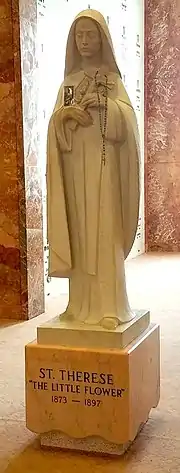

Céline Martin entered the Lisieux convent on 14 September 1894. With Mother Agnes' permission, she brought her camera to Carmel, and developing materials. "The indulgence was not by any means usual. Also outside of the normal would be the destiny of those photographs Céline would make in the Carmel, images that would be scrutinized and reproduced too many times to count. Even when the images are poorly reproduced, her eyes arrest us. Described as blue, described as gray, they look darker in photographs. Céline's pictures of her sister contributed to the extraordinary cult of personality that formed in the years after Therese's death".[111][112]
In 1902, the Polish Carmelite Father Raphael Kalinowski translated her autobiography, The Story of a Soul, into Polish.[113] As early as 1912 Father Thomas N. Taylor, a teacher at the Diocese of Glasgow seminary, wrote a short hagiography on Thérèse, two years before the case for her canonization would be opened. Taylor went on to become a significant proponent of devotion to "The Little Flower" in Scotland.[114] As pastor of St. Francis Xavier Church in Carfin, Lanarkshire, he built a replica of the Grotto at Lourdes and included a small shrine honoring Thérèse with a statue donated by the Legion of Mary. Carfin became a site of pilgrimages.[115]
Recognition
Canonization
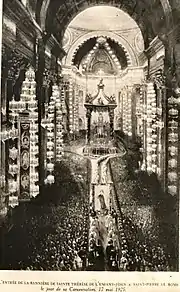
The impact of The Story of a Soul, a collection of her autobiographical manuscripts, printed and distributed a year after her death to an initially very limited audience, was significant. Pope Pius XI made her the "star of his pontificate".[116] Pius X signed the decree for the opening of the process of canonization on 10 June 1914.
Pope Benedict XV, in order to hasten the process, dispensed with the usual fifty-year delay required between death and beatification. On 14 August 1921, he promulgated the decree on the heroic virtues of Therese declaring her "Venerable". She was beatified on 29 April 1923.[90]
Therese was canonized on 17 May 1925 by Pope Pius XI, only 28 years after her death.[117] Therese was declared a saint five years and a day after Joan of Arc. However, the 1925 celebration for Therese "far outshone" that for the legendary heroine of France. At the time, Pope Pius XI revived the old custom of covering St. Peter's with torches and tallow lamps. According to one account, "Ropes, lamps and tallows were pulled from the dusty storerooms where they had been packed away for 55 years. A few old workmen who remembered how it was done the last time – in 1870 – directed 300 men for two weeks as they climbed about fastening lamps to St. Peter's dome." The New York Times ran a front-page story about the occasion titled, "All Rome Admires St. Peter's Aglow for a New Saint". According to the Times, over 60,000 people, estimated to be the largest crowd inside St. Peter's Basilica since the coronation of Pope Pius X, 22 years before, witnessed the canonization ceremonies.[118] In the evening, 500,000 pilgrims pressed into the lit square.[119]
She rapidly became one of the most popular saints of the twentieth century. Her feast day was added to the General Roman Calendar in 1927 for celebration on October 3.[120] In 1969, 42 years later, Pope Paul VI moved it to October 1, the day after her dies natalis (birthday to heaven).[121]
Therese of Lisieux is the patron saint of aviators, florists, illness(es) and missions. She is also considered by Catholics to be the patron saint of Russia, although the Russian Orthodox Church does not recognize either her canonization or her patronage. In 1927, Pope Pius XI named Saint Therese co-patron of the missions, with Saint Francis Xavier. In 1944 Pope Pius XII decreed her a co-patron of France with Saint Joan of Arc.[122] The principal patron of France is the Blessed Virgin Mary.
By the Apostolic Letter Divini Amoris Scientia (The Science of Divine Love) of 19 October 1997, Pope John Paul II declared her the thirty-third Doctor of the Church,[123] the youngest person, and one of only four women so named, the others being Teresa of Ávila, Catherine of Siena and Hildegard of Bingen.
Devotion to Therese has developed around the world.[124] According to some biographies of Édith Piaf, in 1922 the singer – at the time, an unknown seven-year-old girl – was cured from blindness after a pilgrimage to the grave of Therese, who at the time was not yet formally canonized.[125]
Canonization of her parents
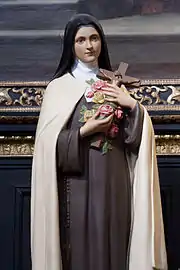
Zélie and Louis Martin were the first spouses to be proposed for canonization as a couple and the first to be canonized together. In 2004, the Archbishop of Milan accepted the unexpected cure of Pietro Schiliro, an Italian child born near Milan in 2002 with a lung disorder, as a miracle attributable to their intercession. Announced by Cardinal Saraiva Martins on 12 July 2008, at the ceremonies marking the 150th anniversary of the marriage of the Venerable Zélie and Louis Martin, their beatification as a couple took place on 19 October 2008,[126] in Lisieux.
In 2011, the letters of Blessed Zélie and Louis Martin were published in English as A Call to a Deeper Love: The Family Correspondence of the Parents of Saint Therese of the Child Jesus, 1863–1885.[48] On 7 January 2013, in Valencia, Spain, the diocesan process opened to examine a "presumed miracle" attributed to their intercession: the healing of a newborn girl, Carmen Pérez Pons, who was born prematurely four days after their beatification and who inexplicably recovered from severe bleeding of the brain and other complications.[126]
On 21 May 2013, the diocesan process to examine the miracle closed and the dossier was sent to the Congregation for the Causes of Saints in Rome. Louis and Zélie Martin were canonized on 18 October 2015.[127]
Canonization cause of her sister Léonie
Therese's older sister, Léonie Martin, the only one of the five sisters who did not become a Carmelite nun, is also a candidate for sainthood. Leonie attempted the religious life three times before her fourth and final entrance in 1899 to the convent of the Visitation in Caen. She took the name Sister Françoise-Thérèse and was a fervent disciple of Therese's way. She died in 1941 in Caen, where her tomb in the crypt of the Visitation Monastery may be visited by the public.[128] On 25 March 2012, Mgr Jean-Claude Boulanger, Bishop of Bayeux and Lisieux, granted the imprimatur for a prayer asking that Leonie might be declared venerable.[129] On 2 July 2015, the diocesan inquiry into Leonie's life and possible sanctity was opened at the chapel of the Monastery of the Visitation at Caen. She is now styled Leonie Martin, Servant of God.
Relics of Saint Therese
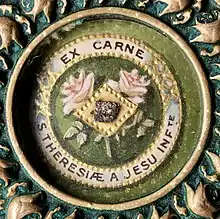
The relics of Saint Therese have been on an international pilgrimage since 1994.[130] The tour included not only first-class relics, but also the saint's religious habit, her rosary, and several other items. They were brought to Ireland in the summer of 2001.[131] That same year they travelled to Canada. Although Cardinal Basil Hume had declined to endorse proposals for a tour in 1997, her relics finally visited England and Wales in late September and early October 2009, including an overnight stop at the Anglican York Minster on her feast day, 1 October. A quarter of a million people venerated them.[132]
Ron Garan, who was on the May 31–June 14 Discovery shuttle mission in 2008, took a relic of Saint Therese with him, which had been given to him by the Carmelites of New Caney, Texas. The Carmelites-based this on the wish of Therese "to preach the Gospel on all five continents simultaneously and even to the most remote isles."[133]
On 27 June 2010, relics of Saint Therese went on their first visit to South Africa in conjunction with the 2010 FIFA World Cup. They remained in the country until October 5, 2010.[134]
The writing-desk Therese used at Carmel (an artifact as opposed to a relic) toured the United States in September and October 2013, sponsored by the Pontifical Mission Societies in the United States.[135]
In November 2013, a new reliquary containing the relics of Saint Therese and of her parents, was presented to the Archdiocese of Philadelphia by the Magnificat Foundation.[136] It was first exposed for veneration at the Magnificat Day on 9 November 2013.
The National Shrine of St. Therese in Darien, Illinois, has the largest collection of relics and personal artifacts of the saint outside of Lisieux.[137]
Episcopal Veneration
In 2022, Thérèse was officially added to the Episcopal Church liturgical calendar with a feast day on 1 October.[138]
Legacy

The Basilica of St. Thérèse in her home town of Lisieux was consecrated on 11 July 1954 and has become a centre for pilgrims from all over the world. It was originally dedicated in 1937 by Cardinal Eugenio Pacelli, later Pope Pius XII. The basilica can seat 3,000 people.[139]
Religious congregations
- The Oblates de Ste. Thérèse[140] were founded in 1933 by Gabriel Martin, a priest in the diocese of Luçon (France) and Béatrix Douillard.[141] Their mission is to evangelize in the parishes and to help Saint Thérèse to "spend her heaven by doing good on earth".
- The Congregation of Saint Thérèse of Lisieux - CST was founded on March 19, 1931, by Fr. Basilius Panatt CST, with permission from Mar Augustine Kandathil, the Metropolitan of the Catholic St. Thomas Christians, as the first Indian religious order for brothers.[142]
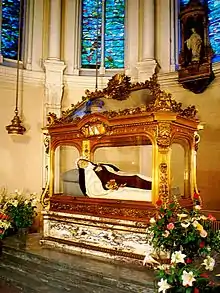
Works inspired by Thérèse
In films
- 1929: Julien Duvivier, La Vie miraculeuse de Thérèse Martin ("The Miraculous Life of Thérèse Martin"), with Simone Bourday as Thérèse.[143]
- 1952: André Haguet, Procès au Vatican ("Trial at the Vatican"),[144] life of Thérèse based on original documents in consultation with the abbé Combes.
- 1964: Philippe Agostini, Le Vrai Visage de Thérèse of Lisieux ("The True Face of Thérèse of Lisieux"), short documentary.[145]
- 1986: Alain Cavalier, Thérèse, biographical evocation with Catherine Mouchet as Thérèse, a film rewarded in 1987 with 6 César Awards including the César Award for Best Film.
- 2004: Leonardo Defilippis, Thérèse: The Story of Saint Thérèse of Lisieux.[143]
In music
- An opera, Thérèse, based on her life, was composed by English composer John Tavener in 1969, shortly before his conversion to Eastern Orthodoxy.[146]
- In 1973, Brazilian composer José Antônio de Almeida Prado composed the oratorio Thérèse, l'Amour de Dieu, for speakers, soloists, chorus and orchestra, based on texts by Thérèse organized by Henri Doublier. The work was commissioned by the French Ministry of Culture and premiered in Rio de Janeiro in 1975.[147]
- The Carmelite monk and musician Pierre Éliane has released four discs on the poetry of Therese. Thérèse songs, three discs from 1992 to 1994, and Sainte Therese de Lisieux – poesies (1997). The original texts are sung in full over melodies composed by Pierre Éliane.
- In 2013 Grégoire set some of the poems of Thérèse to music in an album called Thérèse – Vivre d'amour, with collaborating artists Natasha St-Pier, Anggun, Michael Lonsdale, Grégory Turpin, Les Stentors, Sonia Lacen, Elisa Tovati, Monseigneur di Falco and The Little Singers of Paris.
- Missa Sanctae Theresiae ab Infante Iesu by Serban Nichifor, June 2017.[148]
Devotees of Therese
_%E2%80%93_idt-003.jpg.webp)
Over the years, a number of prominent people have become devotees of Saint Therese of Lisieux.
These include (but are not limited to) the following names listed in alphabetical order (either "name in religion" or "first name + surname").
Religious personalities
Women
- Alphonsa of the Immaculate Conception or Saint Alphonsa - Nun of the Poor Clares, one of the enclosed religious orders. She is the first Indian woman to be canonized in 2008 by Pope Benedict XVI.[149]
- Dina Bélanger - Canadian (province of Quebec), professed religious and a member of the Religieuses de Jésus-Marie. Feeling very close to Thérèse of Lisieux, whom she considers a model, she followed her in the "little way", even though she was not a carmelite. She said: «Therese had to lead me in the way of love and abandonment, to take care of the inner workings of my soul (...) Through her intercession, she opened to me the garden of trust. Then I tasted the true fruit of abandonment. Moreover, she made me advance in the spirit of childhood (...). And all her actions, needless to say, bear the stamp of love».[150] She was beatified in 1993 by Pope John Paul II.
- Maria Candida of the Eucharist - Was inspired by reading The Story of a Soul.[151]
- Mother Teresa of Calcutta, originally called Agnes, explained her choice of the name Teresa as follows: "I chose Therese as my namesake because she did ordinary things with extraordinary love"[152] She and Therese were both deeply drawn by the words of Christ on the Cross: "I thirst.".[153]
Men
- Francis Bourne - British Cardinal - "I love St Therese of Lisieux very much because she has simplified things: in our relationship with God she has done away with the mathematics…".[154]
- Daniel Brottier - "In 1923, Father Brottier's superiors from the Congregation of the Holy Spirit gave him the responsibility to resume [the] great Work of the Orphan-Apprentices of Auteuil. The former military chaplain already had great devotion to the little Carmelite. At the time of his appointment in Auteuil Paris, he decided to build a chapel in honor of Therese who had just been beatified a few months earlier, so that the orphans could pray to their little mama in a sanctuary worthy of her."[155]
- Pope Francis - "When I have a problem I ask the saint, not to solve it, but to take it in her hands and help me accept it."[156]
- Pope John Paul I - "Dear little Thérèse, I was seventeen when I read your autobiography. It struck me forcibly ... Once you had chosen the path of complete dedication to God, nothing could stop you: not illness, nor opposition from outside, nor the mists or inner darkness."
- Maximilian Kolbe offered his first Mass for the intention of the beatification and canonization of Sister Therese of the Child Jesus and the Holy Face. He also dedicated his Asian missions to Therese.[157]
- Marie-Joseph Lagrange - founder of Biblical School in Jerusalem - "I owe to Saint Therese the fact that I didn't become a bookworm. I owe her everything because without her, I would have shrivelled up, my mind dried up."
- Alfredo Obviar - Filipino Bishop and founder of the Missionary Catechists of St. Therese of the Infant Jesus. Pope Francis named him as Venerable in 2018.[158]
- Don Luigi Orione - Italian priest, founder of the Sons of Divine Providence, a clerical congregation of Pontifical Right for men founded in 1903.
- Pio of Pietrelcina, known as « Padre Pio » - Italian Franciscan Capuchin, stigmatist, and mystic.
- Marcel Van, Servant of God, a Vietnamese Redemptorist brother. He allegedly had visions of and conversations with Thérèse. He was heavily influenced by her spirituality, and his teachings are often considered a continuation of her "Little Way."
Lay personalities
Women
- Louise de Bettignies - French secret agent who spied on the Germans for the British during World War I. She received a Catholic education : she did her secondary studies with the Sisters of the Sacred Heart in Valenciennes, France, and her higher studies with the Ursulines at Upton then with the Ursulines at Wimbledon[159][160]
- Benedetta Bianchi Porro - Italian laywoman and mystic, whose sarcophagus in Dovadola includes a quote of Therese, writing «I am not dying, but I am entering life.», and who was read the Act of Oblation to Merciful Love on her own Dies natalis on January 23, 1964. She was proclaimed Venerable in 1993 by Pope John Paul II.
- Louise Brooks - American dancer and actress - "Her spiritual trek was guided by two New York City priests, whom she saw with increasing frequency in late 1952 and early 1953, and by a book about the life of Saint Therese of Lisieux, Storm of Glory by John Beevers. So enamored of Saint Therese was Louise that she spent one entire Sunday propped up in bed with her easel, fashioning a portrait in charcoal on canvas from a small photo of Therese at eight. It was the best and most haunting of her dozen works of art.".[161]
- Lucie Delarue-Mardrus - French writer - "the Carmelite-apparition … appeared, roses in hand, in the midst of an era which grieves and terrifies poets … Thérèse is my fellow-countrywoman, and almost my contemporary. I do not wish to let her glorious entry into sanctity pass by without honoring her in my own way. And besides, she is henceforth public property." (Introducing her book, 1926).
- Gwen John - Welsh painter "Some of her final paintings were in fact of religious subjects [including] countless (over 700) tiny ink copies after a photograph of Thérèse of Lisieux and the saint's elder sister".[162]
- Claudia Koll - Italian, initially an actress, she later became a devout Roman Catholic involved in several humanitarian activities.(Concerning her devotion to Thérèse of Lisieux :).
- Ada Negri - Italian poet and writer.(Concerning her devotion to Thérèse of Lisieux :).
- Edith Piaf - French singer - "Shortly after her birth Edith developed a cataract. She was blind for almost three years. Her grandmother, Louise, took her to Lisieux. She saw. It was a real miracle for Edith. She always believed this. Since that time she had a real devotion to St Therese of the Child Jesus … she always had a small picture of the saint on her bedside table." (Simone Berteaut, Edith Piaf's closest friend).[163]
- Marthe Robin - French Roman Catholic mystic and stigmatist. She said that « on October 3, 1926, the first liturgical Feast of Thérèse of Lisieux, she appeared to her three times, telling her that she would not die, that she would live and that she would continue her mission through foundations throughout the world. ».[164] She was declared venerable by Pope Francis on November 7, 2014.
- Vita Sackville-West, author of The Eagle and the Dove a study of Thérèse of Lisieux and Teresa of Avila - admired the "tough core of heroism" she found in the pages of Histoire d'une âme.[165]
- Anna Schäffer - German woman invalid and mystical. Born into a poor family, she began working at a young age, hoping in her heart to become a nun. At the age of 16, she received a message from Heaven for the first time, a Saint appeared to her (she did not know his name) and told her that she would experience great suffering.Three years later, in 1901, she was severely burned and had to stay in bed permanently. Thus she was unable to fulfil her dream of becoming a nun.[166] She was canonized by Pope Benedict XVI in 2012.
- Delia Smith - British cookery writer - "Therese … not only personified the first beatitude but is, I am deeply convinced, the supreme teacher in regard to the spiritual life."[167]
Men
- Henri Bergson - Nobel prize winner - "One reason why the philosopher Henri Bergson esteemed Therese so highly was that he was fascinated by the qualities of character which prompted her to confront the Pope of her day, Leo XIII, in pursuit of her own desires … explicitly forbidden by the chaplain to address Leo XIII, Therese flouted the injunction..she was dragged away by two papal guards.This is hardly the simpering and docile saint which Therese's statuary too often suggests.".[168]
- Georges Bernanos - "A few months before her death, Therese wrote of ' a wall rising up as far as the heavens … when I sing of the happiness of Heaven, I feel no joy, because I am simply singing of what I WANT TO BELIEVE' (Manuscrits, 248) … Bernanos, a devotee of Thérèse, employs the same image in his novel Diary of a Country Priest, where the priest confides to his diary, Behind me there was nothing. and in front of me a wall, a black wall.[169]
- Gilbert Cesbron - French novelist of Catholic inspiration. In 1952 he wrote a play called Breaking the statue, telling the story of Thérèse.[170]
- Jacques Fesch - Murderer of a French police officer. He was sentenced to death and executed in 1957. While in prison, he became a devout Roman Catholic. In 1987 the Archbishop of Paris, Cardinal Jean-Marie Lustiger opened the cause for his beatification in 1993. But this proposal has been controversial, as some Catholics have argued that, given his crimes, he cannot serve as a model, while others believe that he is an example of conversion.
- Henri Ghéon - French playwright, poet, writer and critic, wrote a book entitled Sainte Thérèse (1934).[171]
- Jean Guitton - French Catholic philosopher and theologian. He expressed his attachment to Thérèse of Lisieux in several of his works, notably in Portrait de Marthe Robin[172][173]
- Brian Desmond Hurst –American film director. (Concerning his devotion to Thérèse of Lisieux :).
- Jack Kerouac - American novelist, had a boyhood habit of praying to Saint Thérèse and was an altar boy.[174]
- Charles Maurras- French author, journalist, poète and political philosopher. . A prolific writer who was very controversial because of his political commitment and writings, which had a real influence on the intellectual world of his time. Initially agnostic, his conversion to Catholicism was, and still is, the subject of much controversy, but hir attachment to Saint Thérèse seems to have been sincere : « In some ways, Maurras was a very modern "Catholic": he was sensitive to the "Little way" of Thérèse of Lisieux »[175][176]
- Alain Mimoun – Algerian-French Olympic marathon champion. He converted from Islam to Roman Catholicism in 1955. Few weeks before the 1956 Olympics in Melbourne, he had doubts about his ability to win. In desperation, following the advice of one of his friends, he went to Lisieux to the Basilica of St. Thérèse . One month later, he won the 1956 Olympics marathon. From that day on, he was convinced that he owed this victory to the help of Saint Thérèse. Since then, every year on October 1, the feast day of the Saint, he has made the pilgrimage to Lisieux[177][178] He said: « St Thérèse of Lisieux is my patron Saint. The white roses which I planted in front of her [her statue in the garden] flower almost all the year round .[179]»
- Giuseppe Moscati – Italian physician and university professor, known for his piety. He was canonised in 1987 by Pope John Paul II.[180]
- Emmanuel Mounier - French writer and philosopher wrote about Thérèse of Lisieux: « At a time when the petit-bourgeois spirit cannot fail to appear as the dullest antipode of the Christian life, would it not be a ruse of the Holy Spirit, [the coming of Thérèse], a paradox of Mercy to have hidden under these banal appearances the mysteries of the highest flame of love?».[181]
- Giovanni Papini - Italian journalist, novelist, poet and philosopher, initially anti-clerical, he converted to Catholicism. He wrote about Thérèse of Lisieux in the posthumous book Il muro dei gelsomini (The Wall of the Jasmine), published in 1957. One of the stories in the book is entitled The Smile of the Saint. He says that as a child he was marked by the smile of a statue of a young girl, in one of the chapels of the church Santa Maria Maddalena dei Pazzi in Florence. A few years later, he discovered that this girl was in fact Thérèse of Lisieux, who had come on a pilgrimage to the same church in 1887 with her parents.[182]
- Marc Sangnier - Founder of Le Sillon - "May Therese from on high support us and show us how to be more one with Jesus."
- Fernando del Valle - American operatic tenor. He received a Catholic education and attended Brother Martin High School in the Roman Catholic Archdiocese of New Orleans. (Concerning his devotion to Thérèse of Lisieux :).
- Maxence Van der Meersch - French Flemish writer of Catholic inspiration. He wrote a religious biography about Thérèse of Lisieux, entitled La petite Sainte Thérèse (1943).
- Jean Vanier - Canadian Catholic philosopher and theologian. In 1964 he founded L'Arche, an international voluntary organisation working primarily for support networks for people with intellectual disabilities. (Concerning his devotion to Thérèse of Lisieux :)
Works
- St. Thérèse of Lisieux (1922). The Story of a Soul. Translated by Taylor, Thomas N. (1873-1963) London: Burns, Oates & Washbourne, 1912; 8th ed., 1922)
Modern editions and English translations
- Saint Thérèse of Lisieux (1977). St. Thérèse of Lisieux, Her Last Conversations. Translated by John Clarke, O.C.D. Washington, DC: Institute of Carmelite Studies Publications. ISBN 978-0-9600876-3-1. ISBN 0-9600876-3-X
- Saint Thérèse of Lisieux (1996). Story of a Soul: the Autobiography of St. Therese of Lisieux. Translated by John Clarke, O.C.D. (3rd ed.). Washington, DC: Institute of Carmelite Studies Publications. ISBN 978-0-9352165-8-5.
- Saint Thérèse of Lisieux (2006). The Story of a Soul (L'histoire d'une âme): the autobiography of St. Thérèse of Lisieux. Translated by Taylor, Thomas N. Teddington, Middlesex: Echo Library. ISBN 978-1-4068-0771-4. ISBN 1-4068-0771-0
See also
- Carmelite Rule of St. Albert
- Constitutions of the Carmelite Order
- List of places named after Saint Thérèse of Lisieux
- National Shrine of the Little Flower
- Secular Order of Discalced Carmelites
- St. Theresa of the Child Jesus Church
- Teresa Janina Kierocińska
- Saint Thérèse of Lisieux, patron saint archive
Notes
References
Citations
- Simar, Jean-Marie; Boubli, Nathalie (2013-12-07). "St. Therese's birthplace". Sanctuaire d'Alençon (Shirne of Alençon). Archived from the original on 2013-12-07. Retrieved 2018-04-19.
- "Prière de la " petite Thérèse " de Lisieux". site-catholique.fr. September 11, 2014.
- "Thérèse et la "petite voie"". March 20, 2005 – via Le Monde.
- McBrien, Richard P. (2001). The Pocket Guide to the Saints (1st paperback ed.). New York: HarperCollins. p. 672. ISBN 0-06065340-X. Retrieved 29 May 2013.
- Flinn, Frank K. (2006). Encyclopedia of Catholicism. New York City: Infobase Publishing. p. 598. ISBN 0-8160-7565-4. Retrieved May 29, 2013.
- Descouvemont (1996), p. 5.
- John Paul II (19 October 1997). "Angelus - Proclamation of St Therese of the Child Jesus and the Holy Face as a "Doctor of the Church"". Holy See: Libreria Editrice Vaticana. Retrieved 13 October 2018.
- "The Life of Saint Thérèse of Lisieux". Holy See: Libreria Editrice Vaticana. Retrieved 13 October 2018.
- Calendarium Romanum (Libreria Editrice Vaticana, 1969), pp. 104, 141.
- Simar, Jean-Marie; Boubli, Nathalie (2015). "Louis a reliable and committed man". Sanctuaire d’Alençon (Shirne of Alençon). Retrieved 2018-04-19.
- Descouvemont (1996), p. 14.
- Simar, Jean-Marie; Boubli, Nathalie (2015). "Zélie, a modern woman". Sanctuaire d’Alençon (Shirne of Alençon). Retrieved 2018-04-19.
- Görres (1959), pp. 41–42.
- "The Early Years". Society of the Little Flower.
- Descouvemont (1996), p. 24.
- Gaucher (1993), p. 19.
- O'Malley, Vincent J., Ordinary Suffering of Extraordinary Saints (1999); ISBN 0-87973-893-6, p. 38.
- Görres (1959), p. 66.
- Gaucher (1993).
- Summarium 1, 1914.
- Görres (1959), p. 73.
- O'Connor (1983), p. 19.
- Descouvemont (1996), p. 53.
- Gaucher (1993), p. 47.
- LaForest (2000), p. 15.
- Saint Thérèse & Taylor (tr.) (2006), p. 32.
- Manuscript A, chapter 3, Story of a Soul.
- Descouvemont (1996), p. 52.
- Monahan (2003), p. 45.
- Monahan (2003), p. 54.
- Harrison (2003), p. 21.
- Görres (1959), p. 112.
- Harrison (2003), p. 63.
- Görres (1959), p. 83.
- Armstrong, Karen (1986) The Gospel according to woman: Christianity's creation of the sex war in the West, p. 234, London, Fount, ISBN 0-006279-53-8
- Furlong, Monica (1987), Thérèse of Lisieux, p. 9, London, Orbis Books, 2001.
- Six, Jean François (1976), La verdadera infancia de Teresa de Lisieux: neurosis y santidad, passim, Mardrid, Studium.
- Thomas à Kempis (2003). The Imitation of Christ. Dover Press. ISBN 0-486-43185-1.
- Görres (1959), pp. 126–127.
- O'Connor (1983), p. 22.
- O'Connor (1983), p. 34.
- Görres (1959), p. 149.
- Jestice, Phyllis G. (2004), Holy people of the world, ABC-CLIO; ISBN 1-57607-355-6.
- Gaucher (1993), p. 77.
- Görres (1959), pp. 153–154.
- Görres (1959), pp. 193–195.
- Görres (1959), p. 201.
- O'Riordan, Maureen (2017). "Saint Therese of Lisieux: A Gateway". Retrieved 2018-04-19.
- Saint Thérèse & Taylor (tr.) (2006), p. 63.
- Gaucher (1993), p. 92.
- Gaucher (1993), p. 99.
- Saint Thérèse of Lisieux (1982). The Letters of St. Therese of Lisieux and Those Who Knew Her. General Correspondence, Volume I: 1877-1890. Translated by John Clarke. ICS Publications. p. 403 (March 1888). ISBN 978-0-96008769-3.
- Harrison (2003), p. 91.
- Görres (1959), pp. 250–251.
- Gaucher (1993), p. 109.
- Görres (1959), pp. 258.
- Isaiah 53:2–3
- Saint Thérèse & Taylor (tr.) (1977), p. 135, "The Yellow Notebook".
- Görres (1959), p. 261.
- Harrison (2003), p. 97.
- Philippians 4:7
- Harrison (2003), p. 98.
- Gaucher (1993), p. 118.
- Saint Thérèse & Clarke (tr.) (1996), pp. 7–8, 279–282.
- Dominican article on Gospel and Therese of Lisieux (in Italian).
- Harrison (2003), p. 108.
- Saint Thérèse of Lisieux (1988). The Letters of St. Therese of Lisieux and Those Who Knew Her. General Correspondence, Volume II: 1890-1897. Translated by John Clarke. ICS Publications. p. 762 (October 1892). ISBN 978-0-93521610-3.
- Görres (1959), p. 114.
- Harrison (2003), p. 111.
- A Memoir of my Sister, written by Céline Martin, is filled with numerous examples of Therese as teacher:
-Céline: Oh! When I think how much I have to acquire! -Therese: Rather, how much you have to lose! Jesus Himself will fill your soul with treasures in the same measure that you move your imperfections out of the way. And Céline recalled a story Therese told about egotism: "The 28 month old Therese visited Le Mans and was given a basket filled with candies, at the top of which were two sugar rings": - Oh! How wonderful! There is a sugar ring for Céline too! On her way to the station however the basket overturned, and one of the sugar rings disappeared. - Ah, I no longer have any sugar ring for poor Céline! Reminding me of the incident she observed: - See how deeply rooted in us is this self-love! Why was it Céline's sugar ring, and not mine, that was lost?.
- Görres (1959), p. 401.
- Proverbs 9:4
- Isaiah 66:12–13
- (in French) Thérèse de l'Enfant-Jésus (1985). Histoire d'une âme. Manuscrits autobiographiques. Paris: Cerf. pp. 236, 302. ISBN 2-20402076-1. Retrieved 12 May 2022.
- Saint Thérèse de Lisieux (2012). The Story of a Soul (L'Histoire d'une Âme). The Autobiography of St. Therese of Lisieux With Additional Writings and Sayings of St. Therese. Hamburg: Tredition GmbH. ISBN 978-3-84720699-6., read online: , a, b-c. Retrieved 12 May 2022..
- Benedict XVI (6 April 2011). "General audience". Holy See: Libreria Editrice Vaticana. Retrieved 13 October 2018.
"little way of trust and love", of spiritual childhood.
- "La petite voie – Le Carmel en France" (in French). Carmel.asso.fr. Retrieved 22 June 2017.
- Pope John Paul II (19 October 1997). "Apostolic Letter of His Holiness Pope John Paul II. Divini amoris scientia. Saint Therese of the Child Jesus and the Holy Face is proclaimed a doctor of the universal church". Holy See: Libreria Editrice Vaticana. Retrieved 13 October 2018.
- Pope Francis (30 December 2015). "General audience". Holy See: Libreria Editrice Vaticana. Retrieved 22 June 2017.
- Pio IX (17 May 1925). "Celebrazione eucaristica in onore di santa Teresa del Bambin Gesù" (in Italian). Holy See: Libreria Editrice Vaticana. Retrieved 13 October 2018.
via dell'infanzia spirituale.
- De Meester, Conrad (1998). The Power of Confidence. Genesis and Structure of the "Way of Spiritual Childhood" of St. Therese of Lisieux. Staten Island: Alba House (Society of Saint Paul). p. 5. ISBN 0-81890819-X.
- Descouvemont (1996), p. 219.
- "In The Little Way Of Saint Therese Of Lisieux". Ecatholic2000.com. Retrieved 2022-03-05.
- Görres (1959), p. 188.
- Görres (1959), p. 189.
- Barnes, David S. (1995). The making of a social disease: tuberculosis in nineteenth-century France. University of California Press. p. 66. ISBN 0-52091517-8.
- Johnson (2001), p. 54.
- Johnson (2001), p. 62.
- Saint Thérèse & Clarke (tr.) (1996), p. 271.
- Lagoutte, Bernard (2012). "About the Relics of saint Therese", Santuaire de Lisieux". Archived from the original on 2012-07-26.
- Saint Thérèse & Taylor (tr.) (1977), p. 44, "The Yellow Notebook".
- Stewart, Barbara (17 October 1999), "A Link to the Quiet Little Life of St. Therese", The New York Times.
- Cumming, Owen F. (2006). Prophets, Guardians, and Saints: Shapers of Modern Catholic History. Mahwah, N.J.: Paulist Press. ISBN 978-0-8091-4446-4. Retrieved 24 May 2013.
- McBrien (2001), p. 399.
- Descouvemont (1996), p. 245.
- Bancroft, Alan (2001), Collected poems of St Thérèse of Lisieux by Saint Thérèse (de Lisieux), ISBN 0-85244-547-4, p. 75.
- Gaucher (1993), p. 2.
- Catholic Faith and Reason (2019). "St. Therese de Lisieux, the Little Flower".. Note: The passage quoted is in the sixth paragraph.Retrieved 12 May 2022.
- Slater, Thomas. "Reparation." The Catholic Encyclopedia Vol. 12. New York: Robert Appleton Company, 1911. 3 October 2017
- Scallan, Dorothy (1990), The Holy Man of Tours; ISBN 0-89555-390-2.
- See Derniers Entretiens, Desclee de Brouwer/Editions Du Cerf, 1971, Volume I, p. 483.
- Redmond, Paulinus (1995), Louis and Zelie Martin: The Seed and the Root of the Little Flower, Cimino Press; ISBN 1-899163-08-5, p. 257.
- Görres (1959), p. 164.
- Nevin (2006), pp. 184, 228.
- LaForest (2000), p. 61.
- Therese of Lisieux. "Holy Face Prayer for Sinners", Catholic.org.
- Descouvemont (1996), p. 137.
- Affidavit by the Reverend Mother Agnes of Jesus. Bayeux Archives, Vol 1
- Fr. Françoise de Sainte Marie, O.C.D, in Introduction (1958), Autobiography of a Saint, translated by Ronald Arbuthnott Knox, p. 13, Harvill Press, ISBN 0-00-623577-8
- Bernard Bonnejean, La Poésie thérésienne, prefaced by Constant Tonnelier, Paris, Éditions du Cerf, 2006; ISBN 978-2-20407-785-9.(in French)
- Harrison (2003), p. 118.
- The Martin family's relentless promotion of Therese and recreating her in a hagiographic image through photographs, paintings, drawings and writings is documented in Sophia Deboick (2011). Image, Authenticity and the Cult of Saint Thérèse of Lisieux, 1897–1959. Univ. of Liverpool.
- Freze, Michael (September 1993). Voices, Visions, and Apparitions. OSV Press. p. 251. ISBN 0-87973-454-X.
- Harris, Alana (2016) "Thérèse of Lisieux", Gareth Atkins, ed., Making and Remaking Saints in Nineteenth-Century Britain, Oxford University Press. ISBN 9780719096860
- Williamson, Clifford (2016) "Chap.5: Carfin and the Little Flower", The History of Catholic Intellectual Life in Scotland, 1918–1965, Palgrave Macmillan. ISBN 9781137333476
- Görres (1959), p. 4.
- "Canonization – Homily of Pope Pius XI at the Canonization of St. Thérèse on 17 May 1925". Eternal Word Television Network. Retrieved 2021-04-04. Source: Taylor, Thomas N. (1930). Saint Thérèse of Lisieux, The Little Flower of Jesus. New York: P.J. Kennedy & Sons. pp. 271–274.
- O'Connor (1983), p. 153.
- Descouvemont (1996), p. 335.
- Calendarium Romanum (Libreria Editrice Vaticana, 1969), p. 104.
- Calendarium Romanum (Libreria Editrice Vaticana, 1969), p. 141.
- "Saint Therese of Lisieux". Patron Saints Index. 2008-12-07. Retrieved 6 June 2014.
- Pope John Paul II (19 October 1997), Divini amoris scientia.
- Nevin (2006), p. 26.
- Burke, Carolyn (22 March 2011). No Regrets: The Life of Edith Piaf. Knopf. p. 10. ISBN 978-0-307-26801-3.
- Juana, Alvaro de (17 October 2015), "The Miracle Behind the Canonization of the Parents of St Therese of Lisieux", Catholic News Agency
- "Pope canonizes first married couple in modern times". CBS News. 18 October 2015. Retrieved 30 October 2018.
- "Servant of God Françoise-Thérèse (Leonie Martin)". Santi e Beati. Retrieved 14 July 2015.
- O'Riordan, Maureen, "Léonie Martin, Disciple and Sister of St. Therese of Lisieux"
- "Pilgrim Saints: Relics on Tour". 2015 Year of Consecrated Life: Rejoice!.
- "Saint's Relics Arrive at Knock on Irish Tour 2001". RTE Archives.
- Arco, Ann (25 September 2009). "Tens of Thousands Flock to St. Thérèse Relics". The Catholic Herald. UK.
- "St. Thérèse Relic Makes Space Flight". November 20, 2008.
- "Saint Therese of Lisieux – St. Therese's Relics Visit South Africa". Thereseoflisieux.org. Archived from the original on 13 March 2013. Retrieved 8 November 2012.
- "Relics of St. Thérèse", Little Flower Catholic Parish, Toledo, Ohio.
- "Saint Thérèse of Lisieux", Magnificat Foundation.
- Colaresi, O. Carm., Bob, "Precious Gifts from Lisieux", The National Shrine of St. Therese, Darien, Illinois.
- "General Convention Virtual Binder". www.vbinder.net. Retrieved 2022-07-22.
- Laurence Fafchamps. "The Basilica". Sanctuaire de Lisieux. Archived from the original on 22 December 2015. Retrieved 19 December 2015.
- The Saint Thérèse of Lisieux's oblates, oblates-sainte-therese.fr; accessed 16 October 2016.(in French)
- ""The foundation's story of the Saint Thérèse of Lisieux's oblates" (2) Archived 2014-03-16 at the Wayback Machine, oblates-sainte-therese.fr; accessed 16 October 2016.(in French)
- Fr. George Thalian. "The Great Archbishop Mar Augustine Kandathil, D. D.: the Outline of a Vocation". Mar Louis Memorial Press. 1961.
- Thérèse of Lisieux at IMDb.
- Titles at IMDb.
- Details at IMDb.
- "Thérèse".
- Valéria Peixoto, ed. (2018). Almeida Prado: Catálogo de Obras [Almeida Prado: Catalog of Works] (PDF) (in Portuguese). Rio de Janeiro: Brazilian Academy of Music. p. 58. ISBN 978-85-88272-40-8.
- Missa Sanctae Theresiae ab Infante Iesu (Nichifor, Serban) at IMSLP.
- "Message of St. Alphonsa". Syro-Malabar Church..
- Text in French: « Thérèse doit me conduire dans la voie de l'amour et de l'abandon, prendre soin du travail intérieur de mon âme. (...) Par son intercession, elle m'a ouvert le jardin de la confiance. Alors j'ai goûté le vrai fruit de l'abandon. De plus, elle m'a fait avancer dans l'esprit d'enfance (...). Et toute son action, inutile de le dire, porte le cachet de l'amour. », read online: (fr) "La bienheureuse Dina Bélanger sœur Marie Sainte-Cécile de Rome". 1997. Retrieved 7 May 2022..
- "Maria Candida of the Eucharist (1884-1949), biography" – via www.vatican.va..
- Mother Teresa by Elaine Murray Stone, 1999 ISBN 0-8091-6651-8 page 9
- I Thirst: Saint Therese of Lisieux and Mother Teresa of Calcutta, by Jacques Gauthier. Staten Island, NY: Alba House, 2005.
- Gaucher (1987), p. .
- De Meester, Conrad, ed. (1997). Saint Therese, Her Life, Times and Teaching. ICS Publications. p. 264. ISBN 0-935216-61-8.
- "Pope Francis and Saint Thérèse of Lisieux: "To depend solely on the tenderness of God" -".
- "April 8, 1998"..
- "Venerable Alfredo Obviar", Oclarim, Semanario Catolico de Macau, November 23, 2018.
- Deruyk, René (1998). Louise de Bettignies: résistante lilloise (1880-1918). p.17. la Voix du Nord. ISBN 978-2-84393-007-2. Retrieved 7 May 2022..
- Annette Becker, La Guerre et la Foi, Armand Colin, 1994.
- Louise Brooks, A Biography ISBN 0-8166-3781-4 Barry Paris, p.431.
- Alison Thomas, Portraits of Women, Gwen John and her Forgotten Contemporaries, Polity Press 1996, p.184.
- Gaucher (1987), p. 224.
- Words reported by the Catholic philosopher Jean Guitton , in his book Portrait de Marthe Robin, Paris, Éditions Grasset, 1985, p. 221, ISBN 9782253039976. The passage quoted is on page 44.
(Text in french: Elle a déclaré que le 3 octobre 1926, jour de la première fête liturgique de Thérèse de Lisieux , celle-ci lui est apparue trois fois, lui disant qu’elle ne mourrait pas, qu’elle vivrait et qu’elle continuerait sa mission par des fondations à travers le monde). - Mary Bryden, saints and stereotypes: The case of Therese of Lisieux, Literature and Theology 1999 Vol 13 (1) p.3 .
- "Kościół ma siedmioro nowych świętych" Deon.pl, October 21, 2012.
- A Journey into God, Delia Smith p.221 ISBN 0-340-49043-8.
- Mary Bryden Literature and Theology, 1999, Vol 13 p.5/6.
- Mary Bryden, Literature and Theology, 1999, Vol 13, p.6/7.
- "Category: Des amis de Thérèse. Gilbert Cesbron". Carmel de Lisieux. Retrieved 8 May 2022..
- Henri Ghéon (1934), Sainte Thérèse de Lisieux, Paris. Reprinted in 2016, by Editions Rassemblement à Son image, p.169, ISBN 978-2-36463-278-3.
- Marthe Robin: her name appears in the list of devotees mentioned above.
- Jean Guitton, in Portrait de Marthe Robin, Paris, Editions Grasset, 1985, pp. 44 and 216.
- "Saint Thérèse of the Child Jesus and the Holy Face: Favorite Saint of Gabrielle Ange L'Evesque Kerouac". 2013. Retrieved 8 May 2022..
- "Charles Maurras et la foi (Charles maurras and faith)". 2007. Retrieved 8 May 2022.. Interview with Axel Tisserand, historian, on the occasion of the publication of his book: Dieu et le roi, correspondance entre Charles Maurras et l'abbé Penon (1883-1928) (God and the King, correspondence between Charles Maurras and the Abbé Penon (1883-1928)), 2007, Editions Privat, 752 p. EAN 9782708968813
Text in French: «Par certains côtés, Maurras fut un « catholique » très moderne : il fut sensible à « la petite voie » de Thérèse de Lisieux.». - In « Lettre de Maurras à Pie XI (Letter to Pius XI), quoted by Pierre Boutang in his book (fr) « Maurras, la destinée et l’œuvre (Maurras, the destiny and the work) », Paris, Éditions Plon, 1984, 593 p.
- "December 1 - the day Mimoun's marathon quest for Olympic gold came good". Insidethegames.biz. 1 December 2019. Retrieved 8 May 2022..
- (fr)"Alain Mimoun, RIP". Chrétienté.info/Le Salon Beige. 28 June 2013. Archived from the original on 21 July 2013. Retrieved 8 May 2022..
- Gaucher (1987), p. 220.
- "Joseph Moscati". Catholic-Forum.Saints. Archived from the original on 2007-08-12. Retrieved 6 May 2022..
- Text written in 1934, included in the posthumous work Refaire la Renaissance, Paris, Éditions du Seuil, 2000, EAN 9782020403993, note 8, pp.382-383. Quoted by Frédéric Gugelot:"Thérèse hors les murs, Chapitre: Patronne des missions, p.17". 2016. Retrieved 6 May 2022.
(Text in french : À une époque où l’esprit petit-bourgeois ne peut manquer d’apparaître comme l’antipode le plus morne de la vie chrétienne, ne serait-ce pas une ruse de l’Esprit-Saint, [la venue de Thérèse], un paradoxe de la Miséricorde que d’avoir caché sous ces apparences banales les mystères de la plus haute flamme d’amour?). - Giovanni Papini, Il Muro dei Gelsomini: Ricordi di Fanciullezza (1957), Società Editrice Internazionale, 180 p. EAN 2565913002537.Digitized by the University of California , 14 January 2009.
Bibliography
- Descouvemont, Pierre (1996). Therese and Lisieux. Helmuth Nils Loose (photography). Grand Rapids, MI: Wm. B. Eerdmans Publishing. ISBN 0-8028-3836-7. (Toronto, ON: Novalis ISBN 2-890-88862-2} (Dublib, Ireland: Veritas Publications ISBN 2-890-88862-2}
- Gaucher, Guy (1987). The Spiritual Journey of St. Thérèse of Lisieux. London: Darton, Longman and Todd. ISBN 0-232-51713-4.
- Gaucher, Guy (1993), Story of a Life: St. Thérèse of Lisieux, Harper Collins, ISBN 978-0-06-063096-6
- Görres, Ida Friederike (1959). The Hidden Face. A Study of St. Thérèse of Lisieux (8th ed.). New York City: Pantheon. ISBN 0-89870927-X.
- Harrison, Kathryn (2003). Saint Therese of Lisieux: A Penguin Life. Penguin. ISBN 978-1-10-165126-1.
- Johnson, Vernon (2001) [1954], Spiritual Childhood: The Spirituality of St. Thérèse of Lisieux (3rd ed.), Ignatius Press, ISBN 9780898708264 ISBN 0-89870-826-5
- LaForest, Ann (2000), Therese of Lisieux: the way to love, Rowman & Littlefield, ISBN 9781580510820 ISBN 1-58051-082-5
- Monahan, Joan (2003), St. Therese of Lisieux: Missionary of Love, ISBN 9780809167104 ISBN 0-8091-6710-7
- Nevin, Thomas R. (2006), Thérèse of Lisieux: God's gentle warrior, Oxford University Press, ISBN 9780198041962 ISBN 0-19-530721-6
- O'Connor, Patricia (1983), Thérèse of Lisieux: a biography, Our Sunday Visitor Press ISBN 0-87973-607-0
Further reading
- Keating, Thomas (2001). St. Thérèse of Lisieux: a transformation in Christ. Lantern Books. ISBN 9781930051201. ISBN 1-930051-20-4
- O'Madagain, Murchadh (2003). Thérèse of Lisieux: Through Love and Suffering. Saint Paul Publications. ISBN 0-854396-65-9
- Tonnelier, Constant (2011). 15 Days of Prayer with Saint Thérèse of Lisieux. New City Press. ISBN 9781565483910. ISBN 978-1-56548-391-0
- "St. Thérèse of Lisieux". Encyclopaedia Britannica.
External links
- Works by Thérèse of Lisieux at LibriVox (public domain audiobooks)

- Works by Thérèse of Lisieux at Open Library
- Works by or about Thérèse of Lisieux at Internet Archive
- Works by or about Thérèse of Lisieux in libraries (WorldCat catalog)